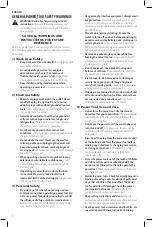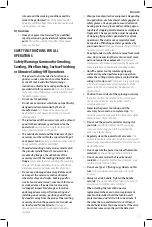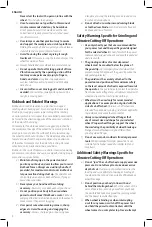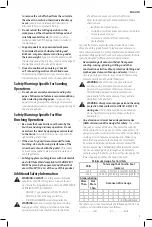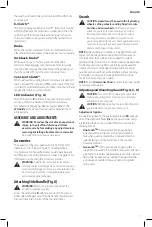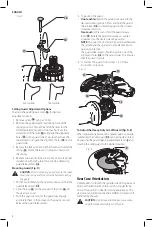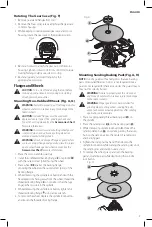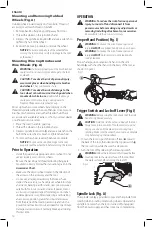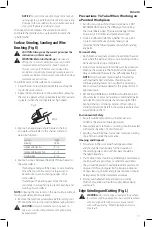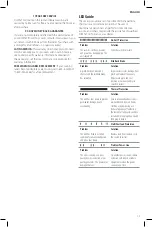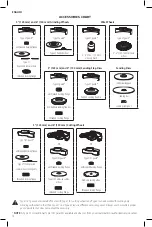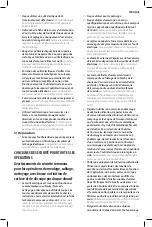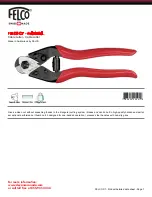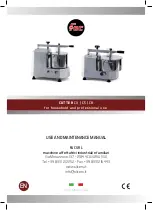
English
3
into account the working conditions and the
work to be performed.
Use of the power tool for
operations different from those intended could result
in a hazardous situation.
5) Service
a )
Have your power tool serviced by a qualified
repair person using only identical replacement
parts.
This will ensure that the safety of the power
tool is maintained.
SAFETY INSTRUCTIONS FOR ALL
OPERATIONS
Safety Warnings Common for Grinding,
Sanding, Wire Brushing, Surface Finishing
or Abrasive Cutting-Off Operations
a )
This power tool is intended to function as a
grinder, sander, wire brush, surface finisher
or cut-off tool. Read all safety warnings,
instructions, illustrations and specifications
provided with this power tool.
Failure to follow all
instructions listed below may result in electric shock,
fire and/or serious injury.
b )
Do not use for polishing.
c )
Do not use accessories which are not specifically
designed and recommended by the tool
manufacturer.
Just because the accessory can
be attached to your power tool, it does not assure
safe operation.
d )
The rated speed of the accessory must be at least
equal to the maximum speed marked on the
power tool.
Accessories running faster than their
rated speed can break and fly apart.
e )
The outside diameter and the thickness of your
accessory must be within the capacity rating of
your power tool.
Incorrectly sized accessories cannot
be adequately guarded or controlled.
f )
Threaded mounting of accessories must match
the grinder spindle thread. For accessories
mounted by flanges, the arbor hole of the
accessory must fit the locating diameter of the
flange.
Accessories that do not match the mounting
hardware of the power tool will run out of balance,
vibrate excessively and may cause loss of control.
g )
Do not use a damaged accessory. Before each
use inspect the accessory such as abrasive
wheels for chips and cracks, backing pad for
cracks, tear or excess wear, wire brush for loose
or cracked wires. If power tool or accessory
is dropped, inspect for damage or install an
undamaged accessory. After inspecting and
installing an accessory, position yourself and
bystanders away from the plane of the rotating
accessory and run the power tool at maximum
no-load speed for one minute.
Damaged
accessories will normally break apart during this
test time.
h )
Wear personal protective equipment. Depending
on application, use face shield, safety goggles or
safety glasses. As appropriate, wear dust mask,
hearing protectors, gloves and workshop apron
capable of stopping small abrasive or workpiece
fragments. The eye protection must be capable
of stopping flying debris generated by various
operations. The dust mask or respirator must
be capable of filtrating particles generated by
your operation.
Prolonged exposure to high intensity
noise may cause hearing loss.
i )
Keep bystanders a safe distance away from work
area. Anyone entering the work area must wear
personal protective equipment.
Fragments of
workpiece or of a broken accessory may fly away and
cause injury beyond immediate area of operation.
j )
Hold the power tool by insulated gripping
surfaces only, when performing an operation
where the cutting accessory may contact hidden
wiring or its own cord.
Cutting accessory contacting
a “live” wire may make exposed metal parts of the
power tool “live” and could give the operator an
electric shock.
k )
Position the cord clear of the spinning accessory.
If you lose control, the cord may be cut or snagged
and your hand or arm may be pulled into the
spinning accessory.
l )
Never lay the power tool down until the
accessory has come to a complete stop.
The
spinning accessory may grab the surface and pull the
power tool out of your control.
m )
Do not run the power tool while carrying it at
your side.
Accidental contact with the spinning
accessory could snag your clothing, pulling the
accessory into your body.
n )
Regularly clean the power tool’s air vents.
The
motor’s fan will draw the dust inside the housing and
excessive accumulation of powdered metal may cause
electrical hazards.
o )
Do not operate the power tool near flammable
materials.
Sparks could ignite these materials.
p )
Do not use accessories that require liquid
coolants.
Using water or other liquid coolants may
result in electrocution or shock.
q )
Do not use Type 11 (flaring cup) wheels on this
tool.
Using inappropriate accessories can result
in injury.
r )
Always use side handle. Tighten the handle
securely.
The side handle should always be used to
maintain control of the tool at all times.
s )
When starting the tool with a new or
replacement wheel, or a new or replacement
wire brush installed, hold the tool in a well
protected area and let it run for one minute. If
the wheel has an undetected crack or flaw, it
should burst in less than one minute. If the wire
brush has loose wires, they will be detected.




